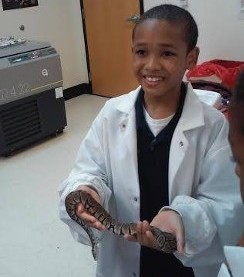THE SCIENCE OF OLYMPIC SPEED SKATING
Speed skating is the fastest propelled sport in the Winter Olympics. Skaters reach speeds of 35 to 40 miles per hour during the race. The key is to keep your speed while passing and maneuvering around the other skaters. Speed skating uses force and movement. In physics, it’s known as Newton’s first three laws of motion.
To win the race, skaters must follow the rules of the sport and laws of physics, starting with Newton’s First Law – an object at rest tends to remain at rest while an object in motion tends to remain in motion.
Skaters dig their front foot into the ice with the tip of their skate and plant their back foot behind them with the whole blade. In this position, they are at rest and will remain at rest. When the whistle blows, the skaters push straight back and accelerate forward.
This is Newton’s Second Law – force on an object produces acceleration. The greater the mass, the sum of all matter in the skater’s body and equipment, the more force he must generate to accelerate down the track.
Learn More
|
|
|
 |
Look, Listen & Learn
Lobsters are invertebrates with a hard protective exoskeleton. Like most arthropods, lobsters must molt in order to grow, which leaves them vulnerable. During the malting process, several species change color. Lobsters have ten walking legs; the front three pairs bear claws, the first of which are larger than the others. Lobsters, like snails, and spiders, have blue blood due to the presence of hemocyanin which contains copper. In contrast, vertebrates and many other animals have red blood from iron-rich hemoglobin.
|
|
|
 |
How A Roller Coaster Works
A roller coaster ¡s something like a passenger train. It consists of a series of connected cars that move on tracks. But unlike a passenger train, a roller coaster has no engine or power source of its own. For most of the ride, the train ¡s moved by gravity and momentum. To build up this momentum, you need to get the train to the top of the first hill (the lift hill) or give it a powerful launch.
Roller coasters are driven almost entirely by basic inertial, gravitational and centripetal forces, all manipulated in the service of a great ride. Amusement parks keep building faster and more complex roller coasters, but the fundamental principles at work remain the same.
Engine: is a machine designed to convert one form of energy into mechanical energy.
Gravity: the force that attracts a body toward the center of the earth, or toward any other physical body having mass.
Inertial: with regard to effort, motion, action, and the like; inactivity; sluggishness.
|
Centripetal Force: the force that is necessary to keep an object moving ¡n a curved path and that is directed inward toward the center of rotation.
Momentum: measured as a product of its mass and velocity.
|
|
|
 |
Look, Listen & Learn
Herpetology (from Greek 'herpien' meaning 'to creep') is the branch of zoology concerned with the study of amphibians (including frogs, toads, salamanders, newts, and caecilians (gymnophiona) and reptiles (including snakes, lizards, amphisbaenids, turtles, terrapins, tortoises, crocodilians, and the tuataras)
|
|
|
 |
Arachnid [uh-rak-nid]
Any wingless, carnivorous arthropod of the class Arachnida, including spiders, scorpions, mites, ticks, and daddy-longlegs, having a body divided into two parts, the cephalothorax and the abdomen, and having eight appendages and no antennae.
|
|
|
|
|